The Transformative Impact of Virtual Reality on Learning and Skill Development
Virtual Reality (VR) technology has been making waves across various sectors, but its potential in education and training is particularly noteworthy. By creating immersive, interactive environments, VR offers unparalleled opportunities for experiential learning and skill acquisition. This article delves into how VR is revolutionizing the way we learn and train, making education more engaging, effective, and accessible.
Why VR in Education?
VR in education transcends traditional learning methods by providing students with immersive experiences that were previously unimaginable. From virtual field trips to historical sites to interactive science experiments, VR enables learners to explore and interact with their subjects in a deeply engaging way. This not only enhances understanding but also retention rates, as learners are more likely to remember what they experience rather than what they merely read or hear.
VR in Professional Training
Beyond the classroom, VR is transforming professional training across industries. For instance, medical students can perform virtual surgeries, offering a risk-free environment to practice and hone their skills. Similarly, VR is used in aviation for flight simulations, allowing pilots to train in various scenarios without the need for actual aircraft. This not only reduces costs but also significantly improves safety during the training process.
The Benefits of VR in Learning and Training
- Enhanced Engagement: VR's immersive nature captures learners' attention like no other medium, making learning more engaging and enjoyable.
- Improved Retention: Experiential learning through VR leads to better retention of information, as it involves multiple senses in the learning process.
- Safe Learning Environment: VR provides a safe space for learners to make mistakes and learn from them, especially crucial in high-risk fields like medicine and aviation.
- Accessibility: VR can make education more accessible, allowing learners from remote or underserved areas to experience high-quality training and education.
Challenges and Considerations
Despite its potential, the integration of VR in education and training is not without challenges. The cost of VR equipment and the need for technical infrastructure can be prohibitive for some institutions. Additionally, there's the need for quality content that is both educational and engaging. However, as technology advances and becomes more affordable, these challenges are likely to diminish, making VR an integral part of education and training.
Looking Ahead
The future of VR in education and training is bright, with ongoing advancements promising even more immersive and interactive learning experiences. As we continue to explore the possibilities, it's clear that VR has the potential to transform traditional learning paradigms, making education more effective, engaging, and accessible to all.
For more insights into how technology is shaping the future of education, check out our articles on the role of AI in education and innovative learning technologies.
